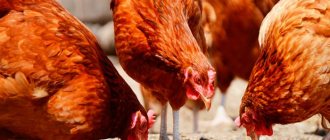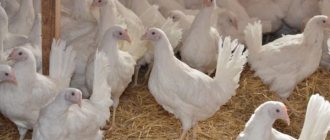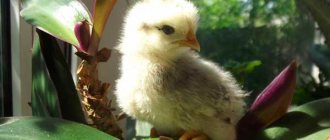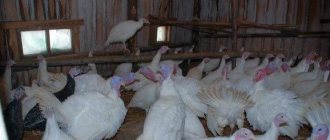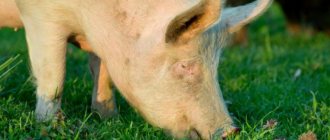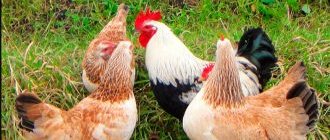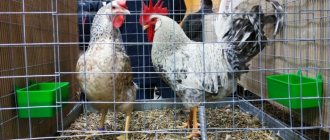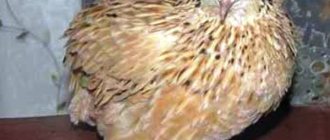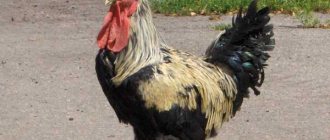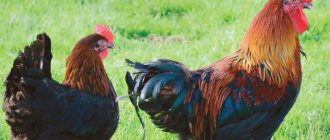The Kuchin anniversary breed of chickens is considered the pride of domestic selection. It was created at the breeding farm of the same name in the Moscow region. The universal-purpose bird has become a favorite of farmers - it is hardy, resilient, highly productive, and on top of that, it’s also beautiful. Before you start breeding this breed, you need to get to know it better and find out what requirements birds have for living conditions, care and nutrition.
Rooster of the Kuchin Jubilee breed
Appearance of laying hens
If we compare hens with males, they are naturally much smaller. However, at the same time, they have a more rounded and lush appearance. The weight of an adult laying hen rarely exceeds the 3 kg mark. The chest is clearly defined, the tummy is large and regular in shape. The body, like most breeds, is trapezoidal. The plumage color is brown, sometimes red-brown. There are black feathers on the chest. The tail is small and has a characteristic black border at the end. Thanks to their downy undercoat, laying hens tolerate low temperatures very well.
The head is medium in size, smaller than that of a cockerel. There is no stubble on the head, and the comb and earrings are small.
Types of colors and their descriptions
Within the Kuchin Jubilee chicken breed there are several variations in plumage color. Based on their description, it is easy to determine which species a particular individual belongs to.
Bordered
The feathers in the mane of the cockerels are golden brown with 2 black stripes and a wide spot of the same shade near the shaft; on the neck they are black with a small golden border. The plumage on the back is golden brown. The tail has feathers of 2 colors: black with a green tint - tail feathers and in braids, juicy red-brown with black stripes along - coverts.
The feathers on the wings have 3 color variations: the coverts are black with a golden brown spot, on the wing arch they are golden brown, on the wing stripe they are also golden brown, but with the last third of the length black. On the chest there is a feather of a rich golden brown color with a black wide border, the body is covered with the same feather, but with a narrow stripe, the belly is dark gray in color, like the down. The legs of Kuchin chickens of this type are yellow.
The color of the plumage of Kuchin Jubilee chickens is slightly different from the color of roosters: on the neck there are feathers with the same pattern, but not golden brown, but light in color, on the back they are the same light brown, but with a black edging. The tail feathers are simply black, while the coverts are a rich golden brown with a black edge. On the rest of the wing the feather is golden brown with a small black border. The flight feathers are black in color with a slight rufous edge along the lower edge, brown-black (second order).
The feather on the chest of the chickens is bright golden brown with a black border at the end. The body of chickens of the fringed variety is covered with golden-brown feathers, the belly is black and gray. These chickens have dark gray down and legs with yellow skin.
Double contoured
Cockerels of this type of color have a bright red head, a black feather on the neck with a bright red edge, the upper feathers are lighter, and the front feathers on the neck are black. The back is covered at the top with feathers, 1/2 black and dark red at the end. In its middle part it is copper-red, dark, glossy. The feather on the saddle is also light red.
The tail tails of chickens of this color variant are black, those in the pigtails are also black, but with a green tint, and the coverts are light red. On the wings the coverts are black, on the arc they are dark red with a pronounced copper sheen, and on the wing stripe they are violet. The flight feathers are black in color with a narrow rufous edge, the second order feathers are with a brownish-red lower web, at the end of which there is a black spot.
The chest of cockerels of this color option is covered with black feathers with small red spots, the belly is covered with black-gray feathers. The down on the entire body of such roosters is dark gray, the legs are ordinary yellow.
Kuchinsky jubilee chickens of this type of color are colored as follows: a light red head, a black feather on the neck with a pale red edging, and a light red feather on the body with clear outlines of a black tint. The tail feathers are predominantly black, while the tail coverts are dark rufous with characteristic outlines. The wings are covered with red-brown feathers with the same outline. On the chest and belly of chickens, the feathers are light reddish-brown with dull outlines. Legs are standard yellow.
Appearance of cockerels
Rhode Island made a major contribution to the appearance of the Kuchin Jubilee males. The cockerels have an iridescent red-brown-black color. The body is triangular in shape, the chest is very powerful, protruding strongly forward. The back is also quite voluminous, the hips are wide, and the paws are strong. Black-green and red feathers spread across the body, or rather over the abdomen and chest, which, in general, create the entire appearance of a representative of this breed.
The wings are relatively small and fit tightly to the body. The head is larger than that of laying hens, decorated with a bright red leaf-shaped crest and large earrings.
The weight of an adult Kuchinsky Jubilee cockerel reaches 3.5-4 kg.
Features of keeping Kuchin chickens
Birds are undemanding to living conditions, but still, when arranging a chicken coop, you need to take into account some features. Birds tolerate cold well and continue to fly even at temperatures of +5 degrees. It is important to ensure that in winter the temperature in the barn does not fall below this level.
Nests and perches in a chicken coop
In the fall, the poultry house needs to be insulated, cracks sealed, and the window covered with plastic film. These measures will help keep the heat inside and avoid additional costs for heating the room. A thick layer of sawdust and peat (20 cm) is laid on the floor. In winter, the flooring is not changed, but only turned over. As a result of chemical reactions, the underlying material decomposes, which leads to the release of heat. Chickens do not freeze on such bedding.
Representatives of the Kuchin breed are clumsy, spending the night on roosts; they often fall and are injured. Experienced farmers recommend installing wide shelves at a height of 40 cm instead of poles; they turn out to be safer. Nest boxes covered with straw are located in a dark, remote corner.
Attention! Kuchinki cannot live in crowded conditions. The recommended population density of the poultry house is 2–3 adults per 1 m2.
The barn must be ventilated. Having a window with a window is a must. High concentrations of ammonia and hydrogen sulfide vapors are dangerous to the health of birds. In winter, chickens need lighting. The duration of daylight hours is 13 hours. For 8–10 sq. m use 1 light bulb with a power of 40–60 W.
The chicken coop is equipped with drinking bowls, feeders, and an ash bath. It is important to keep the inside clean. Unsanitary conditions increase the risk of the spread of infectious and parasitic diseases. Complete disinfection of the poultry house is carried out twice a year - in spring and autumn.
Walk
Kuchin chickens are characterized by increased activity. They need a walking yard. It is arranged on the south side of the chicken coop and fenced with mesh. Representatives of this breed hardly fly, so the height of the fence can be adjusted at will.
Kuchin chickens on the run
The walking area must be equipped with a canopy. It is better to sow it with grass, since birds eat a lot of greenery in the warm season. In summer, walking is not limited; the birds leave the coop early in the morning after eating and enter at dusk. In winter, the hole is opened at lunchtime, when the air warms up a little. The duration of stay in the fresh air depends on the weather, on average - an hour and a half.
Attention! You should not let chickens out for a walk during rain and gusty winds, as well as in severe frost.
What to feed Kuchin jubilee chickens: recommendations
Jubilee chickens are fed in the same way as representatives of other universal breeds. Birds are not picky and willingly eat everything that is offered to them. The basis of their diet is grain:
- wheat;
- oats;
- barley;
- millet.
Legumes are a valuable source of vegetable protein. Birds can be given peas and lentils. Vegetables that are useful for chickens include carrots, fodder beets, pumpkin, zucchini, and potatoes. In the warm season, cucumbers eat a lot of grass; greens make up almost half of their diet. In winter, farmers add dried nettles, dandelions, plantain, and green onions to wet mash. The source of vitamins is sprouted grain.
Sprouted grains are a source of vitamins
Chickens should receive mineral supplements - chalk, bone and grass meal, yeast, crushed egg shells, shell rock. It is especially important to properly create a menu for laying hens in order to maintain egg production at a high level.
Disease Prevention
Chickens of the Kuchin breed have strong immunity. They rarely suffer from colds, but are not immune to health problems caused by improper feeding or poor living conditions.
Common bird diseases:
- skin parasites;
- helminthic infestations;
- avitaminosis;
- pecking
These problems can be prevented by regularly cleaning and disinfesting the chicken coop and monitoring the quality of the birds' diet. Timely vaccination of livestock will protect against infectious diseases.
Character
This is a very active breed. They don't like confined spaces and will do better in a spacious backyard than in a cramped cage or small coop. Chickens have an inquisitive character and very rarely lie on the ground, preferring movement.
If we talk about cockerels, they have a bit of a proud nature and can be aggressive if provoked. In peaceful conditions they are quite calm.
Laying hens are quite noisy. They make noise not only when an egg is laid, but also for other reasons. But not aggressive at all.
What do the owners say about Kuchinsky Jubilee?
People who keep this breed say that the individuals are quite active, but a little nervous. Excessive amounts of feed lead to obesity and loss of egg-laying qualities against this background. Some owners note that egg products are not very large. But such shortcomings are covered by the ability to do masonry even at low temperatures from +3 to + 5 degrees.
This breed enjoys well-deserved love among farmers. High productivity, precociousness of young animals, quick adaptation to various conditions of detention - these are the qualities that Kuchin chickens ideally combine. And if feeding standards are observed, no owner will have any big problems with breeding these beauties.
Puberty
This is an early breed that begins to lay eggs from the beginning of the 5th month of its life (less often from 5.5). Violation of the maturation process can lead to bird disease, overfeeding or underfeeding. In such conditions, laying hens can lay their first clutch later.
This breed cannot be called a full-fledged layer, since it does not reach many crosses, whose indicators exceed 400 eggs per year. On average, chickens produce from 170 to 200 eggs per year. The eggs are quite large, about 60 grams. The shell is brown and quite dense.
Productivity characteristics
The meat productivity of Kuchin chickens is quite good for a meat and egg breed. The live weight of Kuchinsky roosters at 3 months is 2.4 kg, hens - 2 kg, and at approximately 1 year and 1 month they weigh 3.4 kg and 2.7 kg, respectively.
Puberty in Kuchinsky jubilee chickens occurs at 5.5-6.5 months, at which time they begin to lay eggs. They lay eggs almost all year round, with the exception of 2-3 weeks during the molting period. The egg production of Kuchinsky chickens reaches 180 pcs. in a year. The eggs themselves are large, 60 g on average, with a light brown shell. In the second and subsequent seasons, egg production decreases slightly.
Advantages and disadvantages of the breed
On an industrial scale, Kuchinskaya is not in great demand due to the availability of other, more productive crosses. But in the household, this is a fairly popular poultry. Its popularity is explained by a number of advantages that this chicken has:
- These are very friendly, balanced and very kind chickens. They quickly get used to new living conditions and treat their owner and other breeds of chickens well.
- Quite unpretentious in care.
- They are very easy to feed, as chickens are unpretentious to food. They eat mash, grains, vegetables and green grass well. If there is a yard with grass where you can walk them, then they will find food for themselves.
- They mature quickly enough and begin to lay eggs.
- One of those breeds that has not lost the maternal instinct of incubation. Chickens Kuchinskaya Yubileynaya can be bred independently at home.
- They are not afraid of low temperatures, without reducing their productivity.
- They have a rather attractive appearance, which makes the chicken not only productive, but also decorative.
Are there any disadvantages? Eat. First of all, this is a relatively low level of egg production (compared to egg-laying hybrids), which is why chicken is less common in industrial circles. The second disadvantage is obesity. Due to their large size, these birds are prone to obesity. An overweight chicken will naturally become less productive. To prevent obesity, it is necessary to monitor the bird’s diet and not overfeed it.
Brief history of the breed
The Kuchin breed of chickens is the creation of Soviet breeders. In the 50s of the last century, it was decided to create chicken for meat and eggs, characterized not only by high productivity, but also by good adaptability to the Russian climate. The work was carried out for almost 40 years at a breeding poultry farm.
The breed was created on the basis of foreign and domestic genetic material. The following chickens participated in the selection:
- Plymouth Rock;
- New Hampshire;
- Rhode Island;
- australorp;
- Snow White;
- Livenskaya
From breeds of foreign origin, the Kuchin Jubilee has adopted excellent productive qualities in both directions. From the Liven chicken, which completely disappeared shortly after the end of the Great Patriotic War, the new breed received adaptation to local climatic conditions and vitality. It easily tolerates temperature fluctuations and has strong immunity.
In 1990, the Kuchinsky breed was included in the state register, and its standard was approved at the same time. Scientists are going to further improve the resulting line, adding to it the blood of the best meat and egg crosses. So, recently it was improved with the help of leghorns to increase egg production. Today this is one of the best breeds of domestic selection.
Hatching of young animals
The best way to breed young animals of this breed is to use brood hens. A positive result is achieved almost 100%.
Chickens of this breed are distinguished by the fact that the majority of laying hens (about 50%) are ready to become mothers. Moreover, they are good mothers, they treat the young with care, sometimes they even forget to eat.
We recommend reading: Description of the Master Gray chicken breed
Eggs for laying are prepared as follows:
- Large eggs are selected from Kupchinskaya Yubileiny.
- If there are contaminants on the eggs, they must be removed. At the same time, it is very important to understand that eggs cannot be washed (even if you just store them in the refrigerator), since after washing with water, the film above the shell is removed from its surface.
- Eggs for laying are stored in a cool place, in clean containers.
- Place the eggs in the nest in a horizontal position.
- It is advisable to turn the eggs every 3 days.
- Depending on the size of the hen, on average, she hatches from 15 to 19 eggs.
- It is best to place the hen's nest away from other hens. It should be protected from direct sunlight. The approximate dimensions of the nest are 40x40 cm. The bottom of the nest should be covered with dry straw.
- As noted earlier, this breed has a very strongly developed maternal instinct. This may cause them to forget to get up to eat. Therefore, it is necessary to ensure unimpeded access to water and food (preferably dry food).
- After the chicks hatch, they are placed in a warm place (temperature about 28 degrees Celsius).
- When the first plumage appears, the temperature begins to gradually decrease, reaching 20 degrees Celsius.
Breeding
A bright and fairly warm room is suitable for housing Kuchin anniversary chickens, since good lighting contributes to their high egg production.
In the cold season, the chicken coop needs additional insulation and lighting (it is advisable to increase the length of daylight to 12 hours).
Fulfilling these conditions will help to achieve good egg production even in the winter months.
What else you need to know:
- The chicken coop should be kept clean at all times by regularly replacing the bedding and whitewashing the walls. To prevent disease, disinfection of the chicken coop and equipment used is necessary.
- The best place to place the roost is the back wall of the coop. High-quality planed and fairly smooth poles are suitable for this purpose. Its height should not exceed one meter.
- The side wall of the room is suitable for organizing nests (at a height of no more than 60 cm). The best material for bedding is straw.
- To clean feathers and remove parasites, it is necessary to periodically give chickens the opportunity to take dry “baths” from a mixture of wood ash and river sand.
Hatching eggs
Kuchin anniversary hens have a developed maternal instinct, so more than half of them lay eggs voluntarily and do it so selflessly that they can die from hunger and dehydration if they are not periodically driven away from the nest and brought to the feeder. The presence of a downy undercoat allows the hen to warm a clutch of 30 eggs.
Incubation
Eggs intended for laying in the incubator are disinfected for 20 minutes by exposing them to direct sunlight.
The guarantee of ensuring friendly hatching of chickens is compliance with the temperature and humidity conditions:
| Incubation day | Temperature | Humidity level |
| 1-11 | 37,8-38 | 64-68% |
| 12-17 | 37,2-37,4 | 52-55% |
| 18-19 | 37,2-37,4 | 46-48% |
| 20-25 | 36,9-37,1 | 64-68% |
Chicks peck in 20-25 days.
The use of an incubator allows for hatchability to range from 85-94%, whereas when hatching eggs by a hen it is 100%. The vitality of chicks hatched from incubated eggs is higher than that of incubator eggs.
Feeding the young
In the first days of a young animal’s life, it is fed regularly, every 2 hours. Water is also given regularly, except at night, when access to water is limited to no more than 6 hours.
The diet of newborn chicks consists of hard-boiled eggs, ground eggshells and boiled millet. For 25 chickens, use 1 boiled egg.
After a week, grated carrots, cottage cheese, greens (if possible), and crushed grain are added to the chickens’ diet.
In addition, it is recommended to provide chalk and sand in separate containers.
When the chickens are 30 days old, they begin to be fed once every 4 hours. Dry food should be available to young animals regularly.
Chickens of this breed grow faster than representatives of other egg breeds. If chickens are raised for slaughter, then with a properly balanced diet they are ready for this already at 4-5 months of age.
Chickens begin to lay eggs closer to 6 months of their life.
Diseases of Kuchin chickens
Obesity is the main health problem for the breed. Proper feeding prevents its occurrence. Sometimes the following problems occur:
- diarrhea - develops when feeding low-quality food when the chicken gets food poisoning;
- Vitamin deficiency is dangerous for chickens. Appears in the absence of greens in the diet;
- cannibalism - caused by a lack of protein in the diet.
Diseases of Kuchin chickens are associated with improper feeding. A balanced diet solves the problem completely.
Feeding adults
The basis of the diet of chickens of this breed should be grains (about 50%), as well as greens.
In addition, it is necessary to provide laying hens with food rich in minerals and vitamins. Chickens must have access to clean water, which must be changed once in winter and twice in summer.
As noted earlier, Kuchinskaya Jubilee is prone to obesity, so it is necessary to monitor their diet and not overfeed the bird. When gaining excess weight, a chicken's egg production rates drop significantly.
Otherwise, there are no special conditions of detention.
How to feed young and adult birds
Unpretentiousness to the food supply is another positive feature of this breed. Balanced feed, grain crops and wet mash are suitable for them. Newly hatched young animals are given finely mashed boiled eggs or special feed.
As they grow older, they try to diversify their diet with green matter, boiled potatoes, carrots, vitamin and mineral complexes, as well as waste from the fishing industry. From the age of 14 to 21 days, you can give ground grain and cereals.
Adult livestock receive various grain mixtures or feed. Separately place containers with gravel and shell rock, as well as feed chalk.
Chicken and rooster of the Kuchin Jubilee breed
It is recommended to feed wet mash, but here the owner must remember that such food quickly deteriorates, especially in the summer, and the remains of uneaten food must be removed in a timely manner. Water containers must be filled regularly so that the bird can drink 24 hours a day.
Farmer reviews
Vladislav Igorevich, Voronezh, 42 years old.
Now my Jubilee is 6 months old. So far, not a single egg has been given. While we wait. I think I’ll slaughter them all for meat, but until they give me eggs, I want to see the egg production, but I won’t slaughter them. We killed 2 chickens so far, well, I’ll say it, they’re delicious, the meat is fatty. I like the appearance of the chickens; there is no shame in raising them for sale (typical domestic chicken).
Oksana Aleksandrovna, Kyiv, 53 years old.
I took hens and cockerels of this breed. There are 12 cockerels, 11 hens. Of the 12 roosters I had, 6 were normal, well-fed, they went straight to slaughter, but the remaining 5 were like bicycles, so thin. When they gained weight, they were also sent to slaughter. Now there is only one rooster left, as thin as it was, it remains so. He’s intimidated, he runs around like crazy, he’s afraid of us, but they still won’t reach him. Therefore, because of this, there is no clear opinion on the Kuchinskaya Jubilee roosters. But I really like laying hens. I can’t say when the first clutch was laid, I can only say that each one is different, although the age is the same. The eggs are very good, large, never had any small ones. I am more than happy with the chickens, considering their calm disposition.
Maintenance and care
Comfortable living conditions for the black sheep in question are not the main thing. But, there are several features that need to be taken into account when equipping a home and a walk.
- A frost-resistant chicken does not need heating in winter, but it is unacceptable for the temperature in the poultry house to drop below zero. In order to maintain warmth, it is necessary to properly lay deep bedding. It should not be replaced in winter. Bacteria that actively develop in it serve as an additional source of heat. Their life processes are directly related to the release of thermal energy.
- Floor keeping is recommended, since Kuchin chickens are quite large and clumsy - they can fall from their perches and cause trouble not only for themselves, but also for their relatives.
- As a last resort, you can place the family in spacious cages. Some poultry farmers practice this, but it is better if the flock has the opportunity to roam.
- The walk needs to be spacious and the fence low. There is no need to worry that the birds will try to leave their territory - they cannot fly.
- The rest of the rules are the same as others. Cleanliness, disease prevention, protection from pests and rodents.
Molting and break in laying
As the molting season approaches, the poultry farmer needs to be more attentive to the winged family. This is a period that depletes the hens, so in addition, it is useful to supplement them with vitamins and minerals, you can give fish oil for preventive purposes.
The molting process for kuchinkas is short - the break in laying lasts no longer than 1 month. Another break in the clutch may occur during the brooding period.
Planned herd replacement
It's no secret that every year the quons are less and less pleasing with their productivity. The Kuchinskys are no exception. Therefore, poultry farmers recommend keeping jubilee chickens only during the peak period, and then sending them to slaughter, raising a worthy replacement for them - a generation of young animals.
Diseases
Kuchin chickens are generally not prone to diseases. If they are vaccinated, eat well and are not gaining weight, there is no need to worry about their health. The only thing that can annoy them is regular infestations with parasites.
In order to protect beauties from ticks, fleas and other troubles, they should be given the opportunity to take ash baths and periodically treat the house.
What are the reviews?
When do Kuchin laying hens start laying eggs?
The first pullets of Kuchinsky laying hens, received in May, begin to lay eggs by the end of November. This is approximately 6 months. The norm for chickens kept in natural daylight conditions, with two hours of additional lighting. It’s better not in the morning, but in the evening.
It is very important for the chicken that the internal organs are formed correctly during puberty. Why? Early oviposition, caused by excessive supplementary lighting and feeding of mixed feed, negatively affects the development of the uterus of the oviduct, where egg formation occurs. In December, these hens lay eggs fully.
Another part of the hens - more massive, with the so-called feather border on the chest and partially on the back and wings - begins to lay eggs only at 7-8 months. Initially, they produce larger eggs than the laying hens that came in earlier.
The winter diet of chickens includes grated fodder beets, pumpkin, boiled potatoes, cabbage leaves, several types of grains and corn. The mash is supplemented with dried nettles, vitamins, dairy waste, hay dust, and PK-1 feed.
